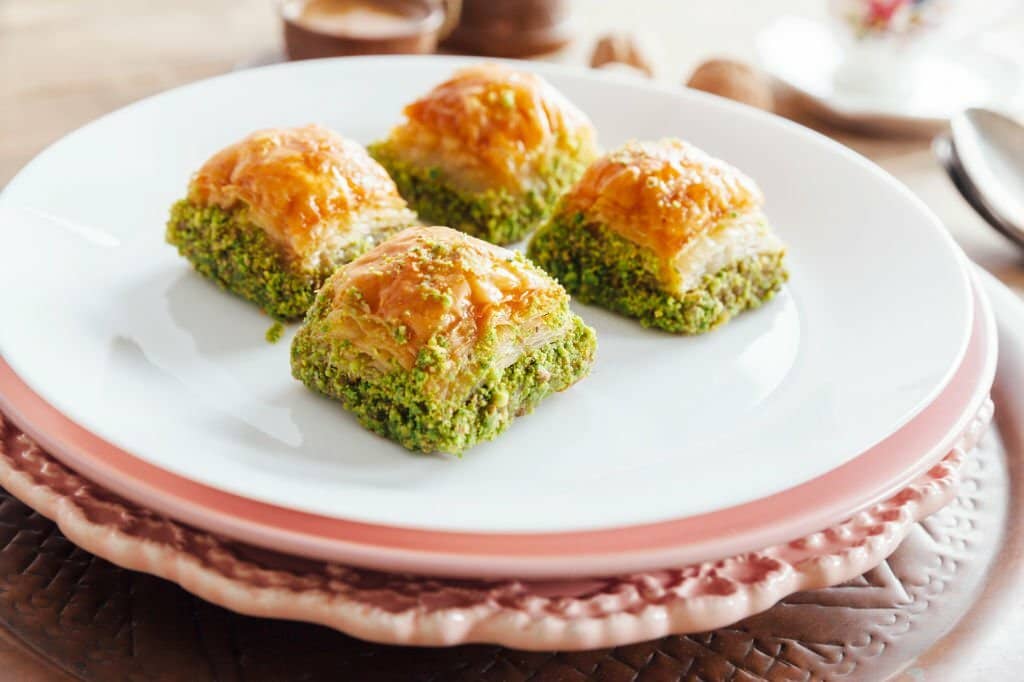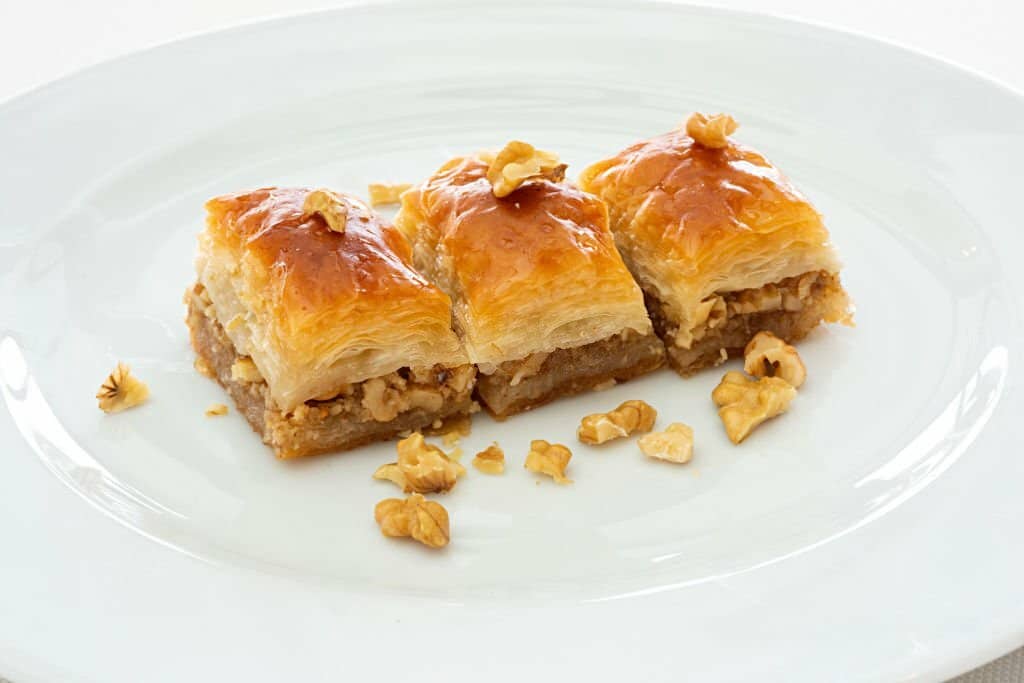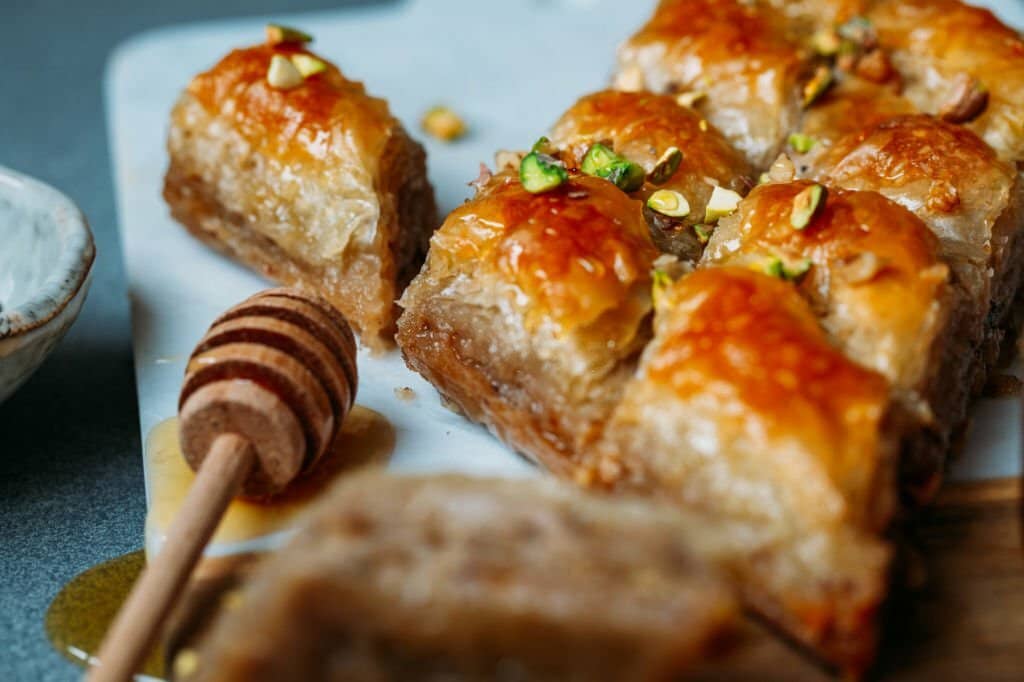Is Baklava Greek or Turkish? Baklava origin is strongly connected to both Greece and Turkish. Nowadays, Baklava is a beloved food of almost every sweet tooth person all over the world.
But this sweet also being the subject of debate because of the different cultural significance and influence that is connected to baklava. People have a common question in their mind is baklava Greek or Turkish? So, we are here to reveal the truth.
What is Baklava?

Baklava is a sweet and rich pastry that is made with layers of phyllo dough, nuts usually walnuts, pistachios, and sweet syrup or honey. It is a popular dessert in many countries including Greece and Turkey, the Middle East, and the Eastern Mediterranean. But each culture has its recipe and style of preparation.
Simply it is made with a thin layer of phyllo dough which is separated by nuts and syrup filling and then baked to golden brown and finally drenched in syrup or honey. The final result is a flaky and crispy layer with the filling of sweet nuts and syrup making a rich and indulgent dessert.
However, the recipe of Baklava may differ according to country or cultural influence. Some may drench Baklava in honey and some in rose water or orange blossom water but the core ingredient dough, nuts, and syrup remain consistent.
Where is Baklava From?
Baklava has a long and complex history but today’s baklava may created in the (Topkapı Palace in Constantinople) modern Istanbul. It is believed to have ancient roots in the Middle East and Eastern Mediterranean with multiple cultures and regions claiming a connection to its creation.
The concept of layered pastry with nuts and honey has a long history in the region. Some of the earliest known ancestors of baklava are found in ancient Mesopotamia and the Assyrian Empire. They believe that it was already prepared in the 8th century BC.
In the Byzantine Empire, people used to make a sweet treat called “gastrin.” It had layers of dough, honey, and nuts but not a flaky pastry layer. This dessert is like an ancestor of modern baklava.
Some people also believe that the Güllaç dessert from Turkish cuisine is the precursor to baklava. It’s made by layering thin sheets of filo dough into warm milk sweetened with sugar. Güllaç is often served with walnuts and fresh pomegranate and is traditionally enjoyed during Ramadan.
The Ottoman Empire played a crucial role in spreading baklava in different cultures and shaping the modern recipe for baklava. It is believed that baklava evolved and was recognized all over the world during the Ottoman Empire.
Is Baklava Greek Or Turkish?

Baklava root is connected to both Greece and Turkey. It has ancient roots in Greece and the Turkish.
In Greece, it is tradition to make baklava with 33 layers of dough and each layer represents the one year of the life of Christ. The word “phyllo,” which means “leaf” in Greek, refers to the thin sheets of dough used in baklava. The origin of the word “Baklava” is Turkish and the layering process is called “bayla” in Mongolia. The word “bakla” in “baklava” is related to this method of stacking the phyllo sheets.
On the other hand, the Turks also have a strong connection to baklava. It is believed that the Ottoman Empire popularised baklava all over the world and also shaped the recipe of today’s baklava. The Sultan gave a baklava tray to soldiers on every 15th day of Ramadan in a special event called the Baklava Parade. This was done to appreciate the army and salute their strength.
Now you understand that baklava origin is not limited to a single culture. It has the influence of both cultures Greece and Turkey. Different early forms of baklava and different origins made this dessert a combination of Western Culture which is now loved in many countries, especially in the Middle East. It is not wrong to say that turkey has a crucial role in shaping this dessert.
Is Greek and Turkish baklava the same?

No, Greece and Turkish baklava are slightly different from each other. Greek baklava is typically made with layers of thick phyllo pastry which are brushed with melted butter and layered with a mixture of chopped nuts. Usually walnuts, or a combination of walnuts and almonds. Between the layers of phyllo and nuts, a sweet syrup made from sugar, and water.
After baking, the syrup soaks into the layers which creates a sweet and sticky dessert. Greek baklava is known for its distinct, rich, and nutty flavor.
Turkish baklava is often made with layers of thin phyllo pastry, filled with a mixture of finely ground pistachios or walnuts. The layers are again brushed with melted butter and baked to a golden brown.
After baking, a sweet syrup or honey is poured over the hot baklava. Turkish baklava is famous for its delicate layers and use of pistachios which give it a slightly different taste compared to its Greek counterpart.
Both Greek and Turkish cultures have their unique variations of baklava. The Greek version is often made with honey while the Turkish version often uses sugar syrup. Greek baklava may use walnuts and Turkish baklava often features pistachios.
What is real baklava made of?
The Baklava recipe has some differences according to regional variation and cultural differences but the core ingredient is always the same. Typically baklava is made of a phyllo dough, nuts, and syrup or honey.
Baklava is made with layers of phyllo dough, nuts usually walnuts, pistachios, and sweet syrup or honey.
Greece has its version of baklava and Turkish has its own. In different regions, the baklava recipe may vary slightly but not much.
Baklava Easy Recipe
Baklava is super crowd-pleasing and a pure indulgence. I am sure you want to make this incredible dessert at home. Try this simple recipe:
Ingredients:
For the Baklava:
- 1 package (16 ounces) phyllo dough, thawed
- 1 cup unsalted butter, melted
- 2 cups mixed nuts (such as walnuts, pistachios, and almonds), finely chopped
- 1 teaspoon ground cinnamon
For the Syrup:
- 1 cup granulated sugar
- 1/2 cup water
- 1/2 cup honey
- 1 teaspoon lemon juice
- 1 cinnamon stick
Instructions:
Prepare the Nuts:
- In a food processor, pulse the mixed nuts until finely chopped. Be careful not to over-process; you want a coarse texture.
- Preheat your oven to 350°F (175°C). Ensure that the phyllo dough is thawed according to the package instructions.
Prepare the Phyllo Dough:
- Unroll the phyllo dough and cover it with a damp kitchen towel to prevent it from drying out. Place a sheet of phyllo dough in a greased baking dish (usually 9×13 inches). Brush the sheet with melted butter.
Layering:
- Continue layering sheets of phyllo dough, brushing each layer with melted butter. After about 8-10 layers, sprinkle a thin, even layer of chopped nuts and a pinch of cinnamon.
- Repeat the layering process until you run out of nuts, finishing with a final layer of phyllo dough on top. Make sure to brush the top layer generously with melted butter.
Cutting:
Using a sharp knife, carefully cut the baklava into diamond or square shapes before baking. This will make it easier to serve after baking.
Bake:
Bake in the preheated oven for about 45-50 minutes or until the baklava is golden brown and crisp.
Make the Syrup:
- While the baklava is baking, combine sugar, water, honey, lemon juice, and a cinnamon stick (if using) in a saucepan. Bring to a boil, then reduce heat and simmer for 15-20 minutes, or until the syrup slightly thickens. Remove the cinnamon stick.
Pour the Syrup:
- Once the baklava is out of the oven, immediately pour the hot syrup evenly over the hot baklava. Allow it to absorb the syrup and cool completely.
Serve:
- Let the baklava cool completely before serving. This dessert is best enjoyed at room temperature.
Summary
Baklava origin is strongly connected to both Greece and Turkey and they contributed to the development of baklava. However, there are various forms of baklava present in different countries but the core ingredient remains the same.
Greece Baklava has a thick dough and is often filled with nuts and syrup or honey however Turkish baklava has a thin layer and is often filled with pistachio, syrup, or honey.
Although the origin of baklava is not clear baklava is loved by many countries, especially in the Middle East, Medeterrian region, Greece, and Turkey.

